
Shellfish is a colloquial and fisheries term for exoskeleton-bearing aquatic invertebrates used as food, including various species of molluscs, crustaceans, and echinoderms. Although most kinds of shellfish are harvested from saltwater environments, some are found in freshwater. In addition, a few species of land crabs are eaten, for example Cardisoma guanhumi in the Caribbean. Shellfish are among the most common food allergens.

Clam is a common name for several kinds of bivalve molluscs. The word is often applied only to those that are edible and live as infauna, spending most of their lives halfway buried in the sand of the seafloor or riverbeds. Clams have two shells of equal size connected by two adductor muscles and have a powerful burrowing foot. They live in both freshwater and marine environments; in salt water they prefer to burrow down into the mud and the turbidity of the water required varies with species and location; the greatest diversity of these is in North America.
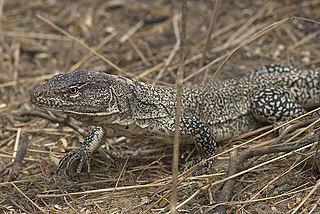
Callopistes is a lizard genus in the family Teiidae. It includes two extant species, which are native to Ecuador, Peru and Chile.

The Pacific razor clam, Siliqua patula, is a species of large marine bivalve mollusc in the family Pharidae.
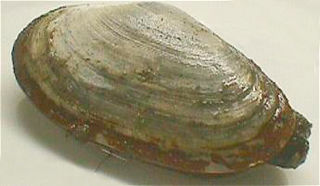
Soft-shell clams or sand gaper, scientific name Mya arenaria, popularly called "steamers", "softshells", "piss clams", "Ipswich clams", or "Essex clams" are a species of edible saltwater clam, a marine bivalve mollusk in the family Myidae.

Pholadidae, known as piddocks or angelwings, are a family of bivalve molluscs similar to a clam.

The hard clam, also known as a quahog, round clam or hard-shellclam, is an edible marine bivalve mollusk that is native to the eastern shores of North America and Central America from Prince Edward Island to the Yucatán Peninsula. It is one of many unrelated edible bivalves that in the United States are frequently referred to simply as clams, as in the expression "clam digging". Older literature sources may use the systematic name Venus mercenaria; this species is in the family Veneridae, the venus clams.
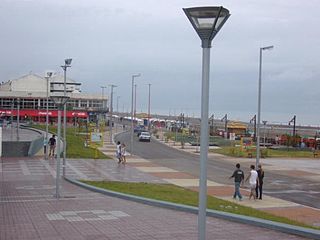
Monte Hermoso is a town located on the Atlantic coast of Argentina, some 100 km (62 mi) east of the city of Bahía Blanca, in the south of the Province of Buenos Aires. It is the administrative seat of the partido of Monte Hermoso.
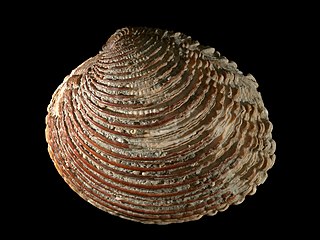
The Veneridae or venerideees, common name: venus clams, are a very large family of minute to large, saltwater clams, marine bivalve molluscs. Over 500 living species of venerid bivalves are known, most of which are edible, and many of which are exploited as food sources.

Monte Hermoso Partido is a partido on the Atlantic coast of Buenos Aires Province in Argentina.

The Atlantic surf clam, also called the bar clam, hen clam, skimmer or simply sea clam, is a very large, edible, saltwater clam or marine bivalve mollusk in the family Mactridae. It is commonly found in the western Atlantic Ocean. Reaching up to 20 centimetres (7.9 in) or more in length, it is much larger than Spisula solida, which resides in the eastern Atlantic coastal waters.

The Petricolidae is a family of saltwater clams, marine bivalve molluscs related to the large family Veneridae or Venus clams. Some authors include these genera within the Veneridae as the subfamily Petricolinae.

Venerupis philippinarum is an edible species of saltwater clam in the family Veneridae, the Venus clams.
Hinasuri is an extinct genus of rhea from the Montehermosan. Its fossils have been found in the Monte Hermoso Formation of Buenos Aires Province, Argentina. The type species is H. nehuensis. Hinasuri was a robust rheid bird, living at a time of increasingly extreme temperatures and decreased precipitation in the Pampean region during the Pliocene–Pleistocene.
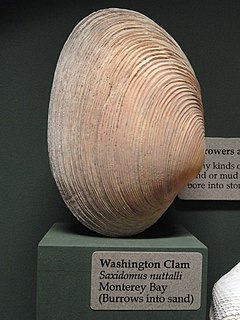
Saxidomus nuttalli is a species of large edible saltwater clam, a marine bivalve mollusk in the family Veneridae, the venus clams. Common names include California butterclam and Washington clam.

Petricola is a genus of saltwater clams, marine bivalve molluscs in the family Veneridae, the Venus clams.

Petricolaria is a genus of saltwater clams, marine bivalve mollusks in the family Veneridae, the Venus clams.

Recalada a Bahía Blanca Light, also known as Monte Hermoso Light or simply Recalada Light, is an active lighthouse in Monte Hermoso, Buenos Aires Province, Argentina, marking the entrance to the Bahía Blanca. At a height of 220 feet (67 m) it is the eleventh-tallest "traditional lighthouse" in the world, as well as the tallest lighthouse in the Southern Hemisphere.

Pholas dactylus, or common piddock, is a bioluminescent clam-like species of marine mollusc found on the coasts of the North Atlantic and the Mediterranean Sea. It bores into gneiss. It was once a highly esteemed food in Europe.
















